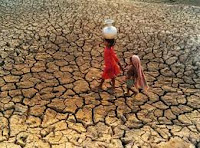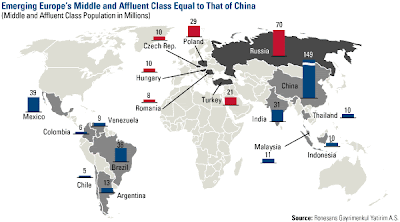A study was completed in early 2010 that mapped threats, like scarcity and pollution, to freshwater supplies at the regional level. This study shows that humankind has, so far, a good record at combating threats to freshwater security is many parts of the world.
Conclusions of the Study
1. About 80% of the world's population exists in areas where freshwater supplies are NOT secure
2. The most severe threat is to 3.4 billion people
Natural Areas of Freshwater Scarcity
Looking at the global map:
- Much of North America (especially the population centers of Canada, US and Mexico) and Western Europe is under high stress. Many areas experience extreme natural stress
- Much of Middle Africa should be fairly unstressed
- Most of India and Western China are under high natural stress.
- There are wide areas with NO natural water flows like, much of Australia, northern and Southern Africa and Inner Asia.
Impact of Human Intervention
Looking at this global map, some startling results are visible:
- Much of North America (except Mexico) is being managed to virtually eliminate natural unavailability of freshwater
- Middle Africa, despite being under few natural forces of water stress, is experiencing extreme freshwater scarcity
- India's water management is somewhat successful at alleviating natural water stresses but has a long way to go to be freshwater secure
- China's water management is somewhat successful at alleviating natural water stresses but has a long way to go to be freshwater secure
Assumptions underlying the Study
Undoubtedly, we need to better understand and agree with all the assumptions, subjective factors, weighing of individual threats, combining of threats, etc before people all over the world will accept how well or how poor a job they have done on freshwater security.
However, there are three conclusions that we should all be able to agree on:
A. The threat of freshwater scarcity is a common threat virtually everywhere around the globe.
B. There are two options to resolve this common threat: We can
EITHER work together, addressing the BIG scale of the threat, to find a universal solution,
OR we leave it to individual nations and regions to work out their individual custom solutions.
C. The problem of freshwater insecurity is so large in scale that time is of the essence i.e. we must eradicate freshwater security quickly before the increasing freshwater demand overwhelms us. This increasing demand is coming in the next decade from the 500+ million people who are expected to dramatically improve their Standard of Living and the 700 million additions to the human population
Conclusions of the Study
1. About 80% of the world's population exists in areas where freshwater supplies are NOT secure
2. The most severe threat is to 3.4 billion people
Natural Areas of Freshwater Scarcity
 |
| Natural areas of Scarcity Source - nature.com |
- Much of North America (especially the population centers of Canada, US and Mexico) and Western Europe is under high stress. Many areas experience extreme natural stress
- Much of Middle Africa should be fairly unstressed
- Most of India and Western China are under high natural stress.
- There are wide areas with NO natural water flows like, much of Australia, northern and Southern Africa and Inner Asia.
Impact of Human Intervention
 |
| Freshwater Managed by Humankind Source - nature.com |
- Much of North America (except Mexico) is being managed to virtually eliminate natural unavailability of freshwater
- Middle Africa, despite being under few natural forces of water stress, is experiencing extreme freshwater scarcity
- India's water management is somewhat successful at alleviating natural water stresses but has a long way to go to be freshwater secure
- China's water management is somewhat successful at alleviating natural water stresses but has a long way to go to be freshwater secure
Assumptions underlying the Study
Undoubtedly, we need to better understand and agree with all the assumptions, subjective factors, weighing of individual threats, combining of threats, etc before people all over the world will accept how well or how poor a job they have done on freshwater security.
However, there are three conclusions that we should all be able to agree on:
A. The threat of freshwater scarcity is a common threat virtually everywhere around the globe.
B. There are two options to resolve this common threat: We can
EITHER work together, addressing the BIG scale of the threat, to find a universal solution,
OR we leave it to individual nations and regions to work out their individual custom solutions.
C. The problem of freshwater insecurity is so large in scale that time is of the essence i.e. we must eradicate freshwater security quickly before the increasing freshwater demand overwhelms us. This increasing demand is coming in the next decade from the 500+ million people who are expected to dramatically improve their Standard of Living and the 700 million additions to the human population





